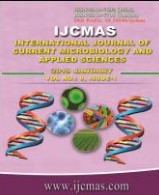


 National Academy of Agricultural Sciences (NAAS)
National Academy of Agricultural Sciences (NAAS)

|
PRINT ISSN : 2319-7692
Online ISSN : 2319-7706 Issues : 12 per year Publisher : Excellent Publishers Email : editorijcmas@gmail.com / submit@ijcmas.com Editor-in-chief: Dr.M.Prakash Index Copernicus ICV 2018: 95.39 NAAS RATING 2020: 5.38 |
The investigation entitled “Response of pigeonpea to drip irrigation and mulching” conducted at college farm, CAET, NAU, Dediapada, during rabi season 2017-18. The experiment consisted of five irrigation treatments and laid-out with randomized block design taking four replications. There were three treatments based on surface drip irrigation method and irrigation schedules in the form of pan evaporation replenishment factors of 0.6 and were either kept constant throughout the crop life and two treatments consisted of irrigation through a furrow system of irrigation scheduled at an IW/CPE: 1 with an irrigation water depth of 60 mm was maintained. Growing of rabi pigeonpea resulted significantly higher yield due to 0.6 significantly higher in 0.6 PEF through drip irrigation with sugarcane trash mulch @ 5 t/ha. Yield attributes as well as yields of pigeonpea were also produced higher through drip with sugarcane trash mulch @ 5 t/ha. The interaction effect observed between irrigation and mulch were significant in respect to plant height at harvest (182.66 cm), number of secondary branches (23.04), grain yield (3318.4 kg/ha), haulm yield (2615.24 kg/ha), fodder yield (2712.21 kg/ha), stalk yield (7749.17 kg/ha), dry root weight (1590.28 kg/ha), harvest index (24.26 %) and water use efficiency (6.84 kg/ha-mm) as compared to rest treatment. WUE decreased with increase in level of irrigation. Drip irrigation 0.6 PEF with sugarcane trash mulch @ 5 t/ha recorded higher WUE with 34.79 per cent water saving as compared to surface irrigation (control). The interaction effect of drip irrigation 0.6 PEF + sugarcane trash mulch @ 5 t/ha, 56 per cent coverage recorded higher net returns (136475.99 Rs/ha) and benefit cost ratio (3.66). For getting potential production and profit from the rabi pigeonpea, scheduling of irrigation at 0.6 PEF through drip with sugarcane trash mulch @ 5 t/ha.
 |
 |
 |
 |
 |